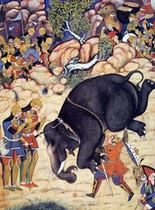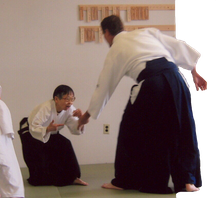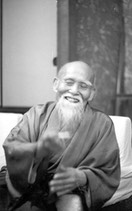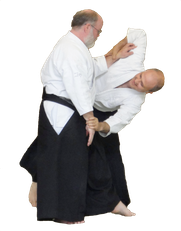Q: Is Aikido the best martial art?
No, thermonuclear warfare is the best martial art; followed by long range artillery, armor, guns, knives, and large guys named Bubba. If you want to defend yourself in the street, buy a tank. Aikido isn't about that, neither is real Budo.
Q: Will I get a workout?
Doing the techniques of Aikido requires little force and no muscle. The movements are calm, centered and flowing. That's half your time on the mat. The other half is "receiving" the techniques which involves falling down and getting up again a couple of hundred times a class. You will be both exhausted and exhilarated.
Q: Do I have to do knuckle pushups? I'm not in great shape. You should only have my bad back! Class begins with slow techniques and back stretches to warm you up; many dojos start with stretches, too. If during the class you get too tired or feel pain, sit down. We're adults here; you don't have to raise your hand.
Q: How's rolling feel with your back? Are we all gonna end up walking like you?
It depends on the kind of drugs I'm on at the time and how recently I've partaken of them. You won't end up hurt if you'd just listen to me, but how many of you listen. You never call; you never write. When you come to the house you don't even bring an assortment! Oy, my aching back.
Q: Is it good for weight control?
No more so than jogging.
Q: Will it hurt?
Now and then there will be pain, but there won't be damage; Aikido does not work by causing injuries. However, no one is allowed to hurt someone maliciously and intentionally on my mat. You are an adult and in charge of your own body. You can always say no.
Q: Does it work "on the street"?
Why do you ask? If you have a fantasy of becoming the invincible ultimate fighting warrior, learning a martial art won't help you achieve it. That's a fantasy, remember? To become "effective" first you have to drop the nonsense and meet Mr. Reality. He's the only one you have to defeat. Unfortunately, he always wins.

Q: What about self defense?
Aikido isn't a quick course in self defense. It takes a while before you could use the techniques. In Brooklyn, we'd answer this question with, "Look, you live in New York City. Sometime in the next five years you'll probably be mugged. They'll take your money, and maybe they'll hurt you. Or you can study Aikido. Here we will take your money every month, and guarantee to hurt you every time you come!"
Q: Aikido -- isn't it just like dancing?
No, dancing is much harder. A famous ballerina once hurt her foot at the beginning of the season, but, since she was used to pain, continued dancing. After the season, she went to a doctor who upon examining her asked, "So when did you break your foot?" She just assumed it was a little muscle pain. How many martial artists could say the same.

Q: Can a woman ever beat a man? Especially a big man?
Yes. Most of my Aikido heros were under 5'4"; tall, under 130 pounds, and over 65 years old. Our friend Vicky was about 4'9" and threw a beefy prison guard so far that he asked if it qualified him for frequent flyer mileage.
Q: What about teenagers?
If a teenager is mature enough to give an adult who's paying to be there the same workout they could get from another adult, they can join adult classes. One mother of a fourteen-year-old who did not pass the maturity test asked us, "So what's wrong with fourteen-year-olds? Are they in exile or something?" The answer for her kid was, "Yes!" The real answer is, as soon as one of us has a kid who's fourteen, there'll be classes for fourteen-year-olds. We're not the public school system; nobody said we have to cover everybody. We do what interests us.
Q: Are there tournaments?
No. Nor trophies or color rank belts. There is no winning or losing and we try to keep the egos to a minimum (mine excepted). The main reason that O Sensei didn't want competitions is that they, by definition, have rules.
Q: Is it, like, a really esoteric, philosophical martial art, with deep roots in Eastern spirituality? Will I learn to meditate and things like that?
Hell yeah.
Q: How long does it take to get a black belt?
Six years, more or less. If you come every day and totally dedicate yoursef to training, it'll take eight.
Q: I really only want to be a Transformer. How much do I get to kick and punch people?
Poof, you're a Transformer. That'll be $100.
Q: Do you ever, you know, "meet" somebody, on the mat?
You'll meet the mate of your dreams and knock him or her down repeatedly. Although it's hard to explain to the parents that your first date included an hour of fighting with men in dresses.
Q: Does Aikido have mood music?
"Kneeling, wo wo wo Kneeling..."
Q: Dear Just Ask Jim: What's that blue thing doing there?
You are either referring to a cut from the "They Might Be Giants" album or to my hakama. So hakama I wear a dress? One word: Tradition! (The chorus from "Fiddler on the Roof" swells in the background.) I've heard a number of explanations of why Aikidoka wear the hakama: they hide our footwork; they're traditional samurai garb; they help us keep our centers, but they're mainly just excuses. I suspect that we wear them because they look cool and give an aura of exotic dignity.

Q: Dear Jim: Why do we bow to the picture of the old geezer?
The little guy with the beard up on the wall? That's O Sensei, Bub, Morihei Ueshiba. The big Kahuna. Capo de tutti Capa, and watch that "geezer" stuff. He's been dead for 27 years and he's still better than you! He started all this. We bow because... because... It's a Tradition! (Second chorus, with dancers.) It's also a good way to separate class time from hanging out time.
Q:Is Aikido a religion? O Sensei was a Shinto priest, wasn't he?No, Aikido isn't a religion. O Sensei never asked his students to believe his preachings, only his teachings. He considered it as an adjunct to whatever your religion was, not as a replacement. He defined his numinous experience through the paradigm of the Shinto symbolism which made up his weltanschauung. And you thought I couldn't be deep, you whelp.
Q: If Aikido is a spiritual discipline, could Jon and Martha have gotten married here?
"...You may now throw the bride."
O-Sensei was very religious but he never asked his students to follow him along the Shinto path. Aikido can, however, be used as an adjunct to most religions in that it should foster health, calmness and centeredness. David Christian says that it gives you little finite opportunties to practice "faith" like when your intuition tells you not to believe that relaxing will really knock Brian over but you try it anyway.
Q: Why do we do that hand wringing thing at the end of warm ups?
Hold on tight, bunkies; things are going to get rough. I'm going to quote Tamura Shihan's answer:
"Furitama is important because every class I followed with O Sensei he did it. Consequently, his pupils, including myself and you, must do it to find our its meaning for ourselves. What O Sensei said, for instance, was `You are standing with one foot put on the rock of the sky, the other foot on the rock of the earth'. This means you are standing in the center of the universe, You receive the ki from the sky and the ki from the earth at the point of unification (where the hands come together, left on top) and you move your hands because it is the mixing point. And that is where the energy takes life."
Tamura Shihan then goes into a comparison with sex which I've left out. No, really.
Q: Dear Jim: Why do we have so many different federations in Aikido? We're USAF under Yamada, but what are the ASU, the AAA, the IAA? What's the deal? What gives?
Hey, there's only so much room in a web page, so you'll get the short version.
The Aikikai Foundation in Tokyo, under Doshu, can recognize anyone it wishes. In the US, Doshu currently grants Hombu certificates to the USAF (under Yamada Shihan), the Aikido Schools of Ueshiba (under Saotome Shihan), the Aikido Association of America (under Toyoda Shihan) and the California Aikido Association, plus a few others. . Each organization then sets their own standards and practices based on their Shihan's ideas of how techniques should be done and how to teach that. There are also about 60 groups that give out black belts in Aikido with no connection to Japan.
